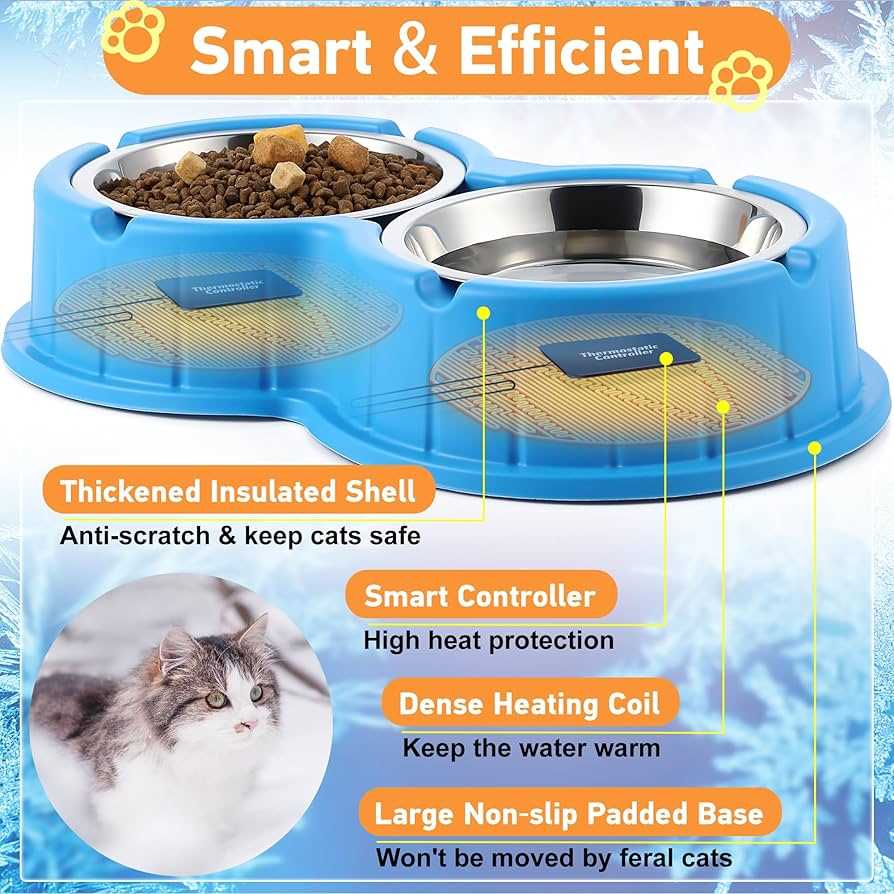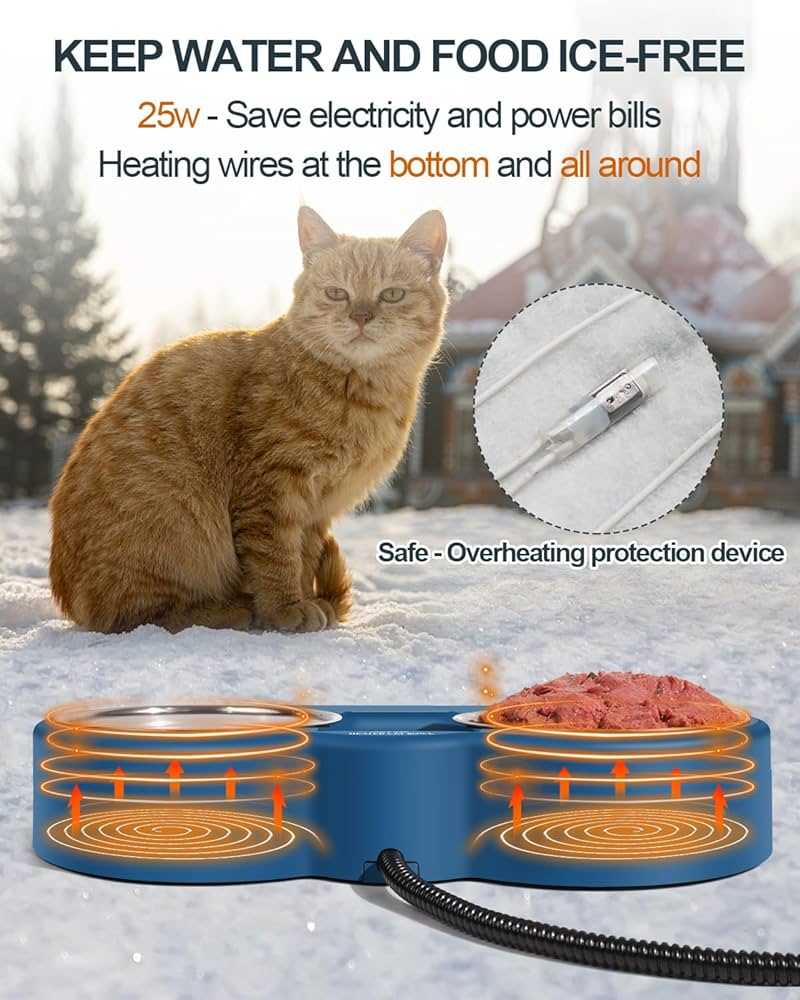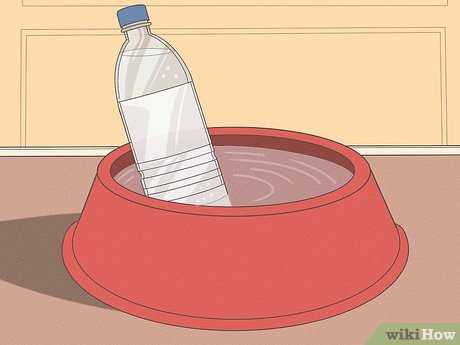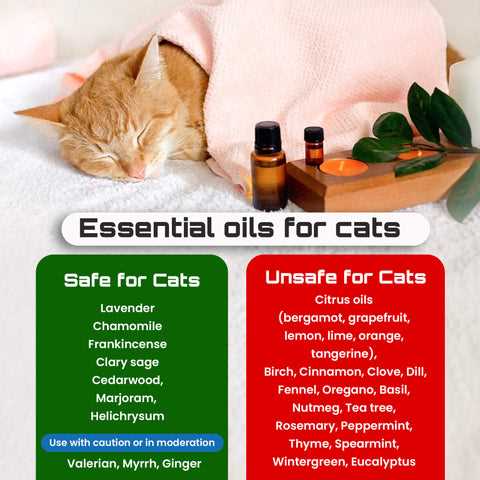Using insulated water bowls can significantly slow down the freezing process. Look for those designed specifically for outdoor use, as they often have thicker walls that provide better insulation. Ensure that the bowls are placed in a sheltered area, away from wind and direct exposure to harsh weather conditions.
Consider adding a small, solar-powered heater to your setup. These devices can keep the liquid at a higher temperature, preventing it from turning into ice. If solar options are limited, a heated water bowl can also do the trick, ensuring a constant supply of warm hydration throughout the colder months.
Regularly check and refresh the contents of the bowls. Even with protective measures, water can still freeze, especially during the coldest nights. By replacing the water multiple times a day, you can ensure that there is always a source of drinkable liquid available.
Incorporating a floating object, like a small ball, can also help. This simple trick disrupts the surface tension, making it more challenging for ice to form. Just be sure the object is safe and won’t pose a choking hazard.
Strategies for Keeping Hydration Accessible

Using insulated bowls can significantly reduce the chance of liquid solidifying in colder temperatures. These containers retain heat and can help maintain a suitable temperature for drinking. Look for products specifically designed for outdoor use, as they often have better insulation properties.
Adding a heated pet water bowl is another practical option. These bowls are equipped with built-in heaters that ensure the liquid remains at a safe temperature, even during freezing conditions. It’s essential to check the product specifications for safety and energy efficiency.
Placement Tips

Positioning the drinking station in a sheltered area can shield it from wind and snow, further aiding in maintaining a liquid state. Consider placing it near a heat source, such as a sunny spot or near a building that absorbs warmth during the day.
Supplementary Ideas
Incorporating a few drops of plain Greek yogurt into the liquid can encourage intake, as many felines enjoy the taste. This might even make them more inclined to go to the bowl regularly. For more insights, check this link on can cats eat plain greek yogurt.
Insulating Bowls to Prevent Ice Formation
Wrap bowls with insulating materials like foam or thick fabric. This minimizes heat loss, keeping the liquid warmer. Use materials that are safe and won’t harm any curious paws.
Elevate the Bowls

Positioning bowls off the cold ground using wooden pallets or bricks can help. Elevation reduces direct contact with freezing surfaces, aiding in maintaining temperature.
Double-Walled Design

Consider using a double-walled bowl. The space between the walls acts as an insulator. Fill this gap with insulating foam or even air for added effectiveness.
Check the bowls regularly. If the surface starts to form ice, break it up gently to ensure hydration remains accessible. This small effort can make a significant difference in the comfort of outdoor friends.
Using Heated Water Sources for Outdoor Cats
Investing in a heated bowl or water dispenser is a smart move. These devices maintain a consistent temperature, ensuring hydration during cold spells. Look for models designed specifically for outdoor use, as they are more durable and weather-resistant.
Solar-powered options are available, providing an eco-friendly alternative. They harness sunlight to keep the liquid warm, making them suitable for areas with ample daylight. Just place them in a sunny spot to maximize their efficiency.
Electric heated bowls require a power source; make sure that cords are securely protected from chewing. Use outdoor-rated extension cords if necessary, and consider adding a GFCI outlet for safety. Regularly check the bowl to ensure it’s functioning properly.
In addition to heat sources, consider placing these bowls in sheltered areas to protect them from wind and snow. Creating a cozy nook can encourage more frequent use by local strays.
For a tasty treat, check out where are temptations cat treats made. Offering snacks alongside fresh hydration can attract wandering felines and keep them coming back.
FAQ:
What are some practical methods to prevent water from freezing for feral cats in winter?
One effective method is to use heated water bowls designed for outdoor use. These bowls have built-in heating elements that keep the water from freezing, ensuring that feral cats always have access to liquid water. Additionally, you can place regular bowls in sheltered areas, away from wind and snow, which can help reduce the likelihood of freezing. Another option is to use insulated containers that trap heat, or even to place a small rock in the bowl that absorbs sunlight during the day and radiates heat at night.
How often should I check and refill the water for feral cats in cold weather?
It’s advisable to check the water supply at least twice a day during the winter months. Water can freeze quickly in low temperatures, so frequent checks ensure that the cats have access to fresh water. If you notice that the water is freezing frequently, consider increasing the number of water sources or using heated bowls. This will help provide a consistent supply of liquid water for the cats, which is crucial for their hydration and overall health.
Are there specific types of containers that work better for keeping water from freezing for feral cats?
Yes, insulated containers work well for preventing water from freezing. Look for bowls made from materials that provide good insulation, such as thick plastic or stainless steel. Some containers are specifically designed for outdoor use and come with insulation that helps maintain a stable temperature. Additionally, using a floating water heater or placing a small, non-toxic substance that can help lower the freezing point of water can be beneficial. Always ensure that the containers are easy to clean and refill to maintain hygiene for the cats.
Using insulated water bowls can significantly slow down the freezing process. Look for those designed specifically for outdoor use, as they often have thicker walls that provide better insulation. Ensure that the bowls are placed in a sheltered area, away from wind and direct exposure to harsh weather conditions.
Consider adding a small, solar-powered heater to your setup. These devices can keep the liquid at a higher temperature, preventing it from turning into ice. If solar options are limited, a heated water bowl can also do the trick, ensuring a constant supply of warm hydration throughout the colder months.
Regularly check and refresh the contents of the bowls. Even with protective measures, water can still freeze, especially during the coldest nights. By replacing the water multiple times a day, you can ensure that there is always a source of drinkable liquid available.
Incorporating a floating object, like a small ball, can also help. This simple trick disrupts the surface tension, making it more challenging for ice to form. Just be sure the object is safe and won’t pose a choking hazard.
Strategies for Keeping Hydration Accessible

Using insulated bowls can significantly reduce the chance of liquid solidifying in colder temperatures. These containers retain heat and can help maintain a suitable temperature for drinking. Look for products specifically designed for outdoor use, as they often have better insulation properties.
Adding a heated pet water bowl is another practical option. These bowls are equipped with built-in heaters that ensure the liquid remains at a safe temperature, even during freezing conditions. It’s essential to check the product specifications for safety and energy efficiency.
Placement Tips

Positioning the drinking station in a sheltered area can shield it from wind and snow, further aiding in maintaining a liquid state. Consider placing it near a heat source, such as a sunny spot or near a building that absorbs warmth during the day.
Supplementary Ideas
Incorporating a few drops of plain Greek yogurt into the liquid can encourage intake, as many felines enjoy the taste. This might even make them more inclined to go to the bowl regularly. For more insights, check this link on can cats eat plain greek yogurt.
Insulating Bowls to Prevent Ice Formation
Wrap bowls with insulating materials like foam or thick fabric. This minimizes heat loss, keeping the liquid warmer. Use materials that are safe and won’t harm any curious paws.
Elevate the Bowls

Positioning bowls off the cold ground using wooden pallets or bricks can help. Elevation reduces direct contact with freezing surfaces, aiding in maintaining temperature.
Double-Walled Design

Consider using a double-walled bowl. The space between the walls acts as an insulator. Fill this gap with insulating foam or even air for added effectiveness.
Check the bowls regularly. If the surface starts to form ice, break it up gently to ensure hydration remains accessible. This small effort can make a significant difference in the comfort of outdoor friends.
Using Heated Water Sources for Outdoor Cats
Investing in a heated bowl or water dispenser is a smart move. These devices maintain a consistent temperature, ensuring hydration during cold spells. Look for models designed specifically for outdoor use, as they are more durable and weather-resistant.
Solar-powered options are available, providing an eco-friendly alternative. They harness sunlight to keep the liquid warm, making them suitable for areas with ample daylight. Just place them in a sunny spot to maximize their efficiency.
Electric heated bowls require a power source; make sure that cords are securely protected from chewing. Use outdoor-rated extension cords if necessary, and consider adding a GFCI outlet for safety. Regularly check the bowl to ensure it’s functioning properly.
In addition to heat sources, consider placing these bowls in sheltered areas to protect them from wind and snow. Creating a cozy nook can encourage more frequent use by local strays.
For a tasty treat, check out where are temptations cat treats made. Offering snacks alongside fresh hydration can attract wandering felines and keep them coming back.
FAQ:
What are some practical methods to prevent water from freezing for feral cats in winter?
One effective method is to use heated water bowls designed for outdoor use. These bowls have built-in heating elements that keep the water from freezing, ensuring that feral cats always have access to liquid water. Additionally, you can place regular bowls in sheltered areas, away from wind and snow, which can help reduce the likelihood of freezing. Another option is to use insulated containers that trap heat, or even to place a small rock in the bowl that absorbs sunlight during the day and radiates heat at night.
How often should I check and refill the water for feral cats in cold weather?
It’s advisable to check the water supply at least twice a day during the winter months. Water can freeze quickly in low temperatures, so frequent checks ensure that the cats have access to fresh water. If you notice that the water is freezing frequently, consider increasing the number of water sources or using heated bowls. This will help provide a consistent supply of liquid water for the cats, which is crucial for their hydration and overall health.
Are there specific types of containers that work better for keeping water from freezing for feral cats?
Yes, insulated containers work well for preventing water from freezing. Look for bowls made from materials that provide good insulation, such as thick plastic or stainless steel. Some containers are specifically designed for outdoor use and come with insulation that helps maintain a stable temperature. Additionally, using a floating water heater or placing a small, non-toxic substance that can help lower the freezing point of water can be beneficial. Always ensure that the containers are easy to clean and refill to maintain hygiene for the cats.
Using insulated water bowls can significantly slow down the freezing process. Look for those designed specifically for outdoor use, as they often have thicker walls that provide better insulation. Ensure that the bowls are placed in a sheltered area, away from wind and direct exposure to harsh weather conditions.
Consider adding a small, solar-powered heater to your setup. These devices can keep the liquid at a higher temperature, preventing it from turning into ice. If solar options are limited, a heated water bowl can also do the trick, ensuring a constant supply of warm hydration throughout the colder months.
Regularly check and refresh the contents of the bowls. Even with protective measures, water can still freeze, especially during the coldest nights. By replacing the water multiple times a day, you can ensure that there is always a source of drinkable liquid available.
Incorporating a floating object, like a small ball, can also help. This simple trick disrupts the surface tension, making it more challenging for ice to form. Just be sure the object is safe and won’t pose a choking hazard.
Strategies for Keeping Hydration Accessible

Using insulated bowls can significantly reduce the chance of liquid solidifying in colder temperatures. These containers retain heat and can help maintain a suitable temperature for drinking. Look for products specifically designed for outdoor use, as they often have better insulation properties.
Adding a heated pet water bowl is another practical option. These bowls are equipped with built-in heaters that ensure the liquid remains at a safe temperature, even during freezing conditions. It’s essential to check the product specifications for safety and energy efficiency.
Placement Tips

Positioning the drinking station in a sheltered area can shield it from wind and snow, further aiding in maintaining a liquid state. Consider placing it near a heat source, such as a sunny spot or near a building that absorbs warmth during the day.
Supplementary Ideas
Incorporating a few drops of plain Greek yogurt into the liquid can encourage intake, as many felines enjoy the taste. This might even make them more inclined to go to the bowl regularly. For more insights, check this link on can cats eat plain greek yogurt.
Insulating Bowls to Prevent Ice Formation
Wrap bowls with insulating materials like foam or thick fabric. This minimizes heat loss, keeping the liquid warmer. Use materials that are safe and won’t harm any curious paws.
Elevate the Bowls

Positioning bowls off the cold ground using wooden pallets or bricks can help. Elevation reduces direct contact with freezing surfaces, aiding in maintaining temperature.
Double-Walled Design

Consider using a double-walled bowl. The space between the walls acts as an insulator. Fill this gap with insulating foam or even air for added effectiveness.
Check the bowls regularly. If the surface starts to form ice, break it up gently to ensure hydration remains accessible. This small effort can make a significant difference in the comfort of outdoor friends.
Using Heated Water Sources for Outdoor Cats
Investing in a heated bowl or water dispenser is a smart move. These devices maintain a consistent temperature, ensuring hydration during cold spells. Look for models designed specifically for outdoor use, as they are more durable and weather-resistant.
Solar-powered options are available, providing an eco-friendly alternative. They harness sunlight to keep the liquid warm, making them suitable for areas with ample daylight. Just place them in a sunny spot to maximize their efficiency.
Electric heated bowls require a power source; make sure that cords are securely protected from chewing. Use outdoor-rated extension cords if necessary, and consider adding a GFCI outlet for safety. Regularly check the bowl to ensure it’s functioning properly.
In addition to heat sources, consider placing these bowls in sheltered areas to protect them from wind and snow. Creating a cozy nook can encourage more frequent use by local strays.
For a tasty treat, check out where are temptations cat treats made. Offering snacks alongside fresh hydration can attract wandering felines and keep them coming back.
FAQ:
What are some practical methods to prevent water from freezing for feral cats in winter?
One effective method is to use heated water bowls designed for outdoor use. These bowls have built-in heating elements that keep the water from freezing, ensuring that feral cats always have access to liquid water. Additionally, you can place regular bowls in sheltered areas, away from wind and snow, which can help reduce the likelihood of freezing. Another option is to use insulated containers that trap heat, or even to place a small rock in the bowl that absorbs sunlight during the day and radiates heat at night.
How often should I check and refill the water for feral cats in cold weather?
It’s advisable to check the water supply at least twice a day during the winter months. Water can freeze quickly in low temperatures, so frequent checks ensure that the cats have access to fresh water. If you notice that the water is freezing frequently, consider increasing the number of water sources or using heated bowls. This will help provide a consistent supply of liquid water for the cats, which is crucial for their hydration and overall health.
Are there specific types of containers that work better for keeping water from freezing for feral cats?
Yes, insulated containers work well for preventing water from freezing. Look for bowls made from materials that provide good insulation, such as thick plastic or stainless steel. Some containers are specifically designed for outdoor use and come with insulation that helps maintain a stable temperature. Additionally, using a floating water heater or placing a small, non-toxic substance that can help lower the freezing point of water can be beneficial. Always ensure that the containers are easy to clean and refill to maintain hygiene for the cats.







